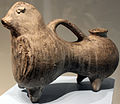Aquamanile
An Aquamanile (also: Aquaemanale, Aquimanile, Aquiminale, Aquiminarium ) is a vessel for washing hands , either during liturgical acts (then mostly made of metal ) or in the secular area before meals (then partly made of ceramic material). Mostly animal figures and mythical creatures are depicted , but knights in full armor can also be found.
Medieval aquamaniles, Germanic National Museum in Nuremberg
Aquamanile around 1170/80, Aachen Cathedral Treasury
Clay aquamanile, 14th century. Germanic National Museum Nuremberg
Löwen-Aquamanile, Northern Germany, early 13th century, Museum of Art and Industry Hamburg
Source area is Orient , came through trade Aquamanile in the early Middle Ages to Europe and were assimilated. The oldest aquamaniles had the shape of a human head, for example a vessel that is kept in Aachen Cathedral . They had their heyday in the High and Late Middle Ages.
The two largest collections of high and late medieval bronze aquamanils are in the Danish National Museum in Copenhagen and in the Germanic National Museum in Nuremberg. The aquamaniles exhibited in the Germanisches Nationalmuseum give an overview of the formal development of the genre and the variety of motifs.
literature
in order of appearance
- August Mau : Aquaemanale . In: Paulys Realencyclopadie der classischen Antiquity Science (RE). Volume II, 1, Stuttgart 1895, Col. 310 f.
- Heinrich Reifferscheid : About figurative pouring vessels of the Middle Ages . In: Communications from the Germanisches Nationalmuseum Nürnberg , year 1912, pp. 3–93.
- Wlodzimierz Antoniewicz: Aquamaniles du moyen age . s. l., 1926.
- Otto von Falke, Erich Meyer: Romanesque candlesticks and vessels. Casting vessels of the Gothic period (bronze devices of the Middle Ages, vol. 1). Berlin 1935 (again: 1983, ISBN 978-3-87157-093-3 ).
- Michael Hütt: "Quem lavat unda foris ..." - Aquamanilien, use and form . Mainz 1993, ISBN 3-8053-1400-0 .
- Ulrich Müller: Between use and meaning. Studies on the function of material culture using the example of medieval hand washing dishes (5th / 6th to 15th / 16th centuries) . Bonn 2006, ISBN 3-7749-3223-9 .
- Michael Brandt (Ed.): Image & Bestie. Hildesheim bronzes from the Staufer period (exhibition catalog Hildesheim 2008). Regensburg 2008, ISBN 978-3-7954-2044-4 .
- Ursula Mende: The medieval bronzes in the Germanic National Museum . Nuremberg 2013, ISBN 978-3-936688-62-7 .
- Joanna Olchawa: The Magdeburg Aquamanilien of the 12th century as multiples . In: Walter Cupperi (Ed.): Multiples in Pre-Modern Art . Zurich 2013, pp. 99–126.
- Joanna Olchawa: Anthropomorphic Aquamanilien as liturgical hand washing vessels and "Ornamenta Ecclesiae" . In: Ute Seiderer, Michael Fisch (Ed.): Skin and shell - envelope and packaging. Enclosing and disguising techniques . Berlin 2014, Vol. 1, pp. 45–64.
- Claudia Höhl, Gerhard Lutz, Joanna Olchawa (eds.): Drachenlandung. A Hildesheim dragon aquamanile from the 12th century (= objects and elites in Hildesheim, 1130–1250, vol. 1). Regensburg 2017, ISBN 978-3-7954-3228-7 .
- Joanna Olchawa: Sirens, pigeons and lions washing hands . The importance of water in the iconography of aquamanilien . In: Gerlinde Huber-Rebenich (Ed.): Use and symbolism of water in medieval culture . Bern 2017, pp. 572-584.
- Joanna Olchawa: Aquamanilien of the Middle Ages and their use . In: Robert Jütte, Romedio Schmitz-Esser (ed.): Hand use. Stories by hand from the Middle Ages and early modern times . Paderborn 2019, pp. 39–58.
- Joanna Olchawa: Aquamanilien. Genesis, distribution and significance in Islamic and Christian ceremonies (bronze devices of the Middle Ages, vol. 8). Regensburg 2019, ISBN 978-3-7954-3492-2 .
Individual evidence
- ↑ Poul Grinder-Hansen: Guides to the National Museum: Danish Middle Ages and Renaissance , Nationalmuseet, Copenhagen 2002, ISBN 87-89384-98-9 .
- ↑ Frank M. Kammel, Thomas Brehm, Claudia Selheim (eds.): Germanisches Nationalmuseum - Guide through the collections , Nuremberg 2017, ISBN 978-3-946217-10-7 , p. 51.
Web links
- Reconstruction of bronze and ceramic aquamaniles at Foracheim
- Several reconstructions and description of the manufacture of bronze aquamaniles at archaeometallurgie.de




